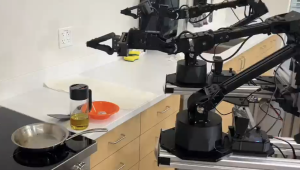The HR world has been so stunned by the progress of- and speed of adoption in Generative AI, that the profession has arguably overlooked the equally intriguing world (and advances) in robotics.
Robotics won’t directly affect employees in HR, however, if they affect a lot of other employees, then HR needs to take note
What’s new in robotics
As we all know, robots have played a major role in manufacturing for decades.
What’s new is that the old robots were highly specialized and meant to operate in tightly controlled environments.
The new robots aim to be the stuff of science fiction, where they can handle almost any physical task a human could.
There have been significant engineering advances in making the body of the robot cheaper, faster, more dexterous, and so on.
However, the most important advance is that it’s turning out to be easier than expected to train these robots.
Google and Stanford collaborated on a robot called Mobile ALOHA (below), which can learn tasks such as cooking a meal and cleaning up simply by being led through it by a human about 50 times.

Even more impressive, a robot made by FigureAI, has learned how to make coffee just by watching videos (below):

Finally, robots can teach themselves to do things in a virtual world (in silico), and that often translates very effectively to the real, physical world – although to be fair, the robots may need significant human help to set up a situation where they can learn for themselves.
HR’s role with respect to robots
The takeaway from all these advances is that between a better ability to build robots and a much better ability to train them, widespread use of humanoid robots appears likely in about 10 years.
As such, HR’s role with respect to robots will be driven by workforce planning.
An operations manager, no doubt besieged by vendors like FigureAI, Tesla, Boston Dynamics, Hanson Robotics, 1X Technologies (and more), will likely suggest that robots can replace some workers.
If the numbers are small then it’s no big deal.
But if the number of employees we now need in a department is much smaller however, then HR will need to consider:
- Can we retrain employees for other jobs?
- Will we need to prepare for layoffs?
- Are there job redesign issues we need to be involved with?
- Do employees or their unions need reassurance?
The last item must not be overlooked, and it’s an issue where HR, rather than operations, can play a leading role.
A worker revolt is the last thing the organization needs, and proactively addressing fears and negotiating compromises is the best approach.
For once, maybe we don’t need to worry
There is some good news though.
While the idea of a world filled with humanoid robots feels odd now, and in many places it will likely happen slowly enough that organizations will be able to handle it relatively easily.
Robots are expensive and only so many will be brought in at once.
Many jobs requiring manual labor have high turnover and worker shortages, so there may be no need to let go of workers.
Also, HR can simply cut back on hiring as robots become capable of filling empty positions.
So what HR should do right now?
HR should be aware that any automation or other business changes will have a significant impact on employees and the work they do.
The rise of humanoid robots introduces new areas where employees may be impacted and HR needs to be alert to that.
That simply means HR ought to have conversations with the operations managers who will be making the decision to purchase robots.
I would argue it’s a conversation to have every year though, because the rate of advancement in robots is unpredictable.
However, we’ve moved from the days when humanoid robots were science fiction to a day where you can buy one to work in your factory.
Perhaps buying one this year, just so the company and its employees could get some familiarity with the technology, would be the right proactive move.
